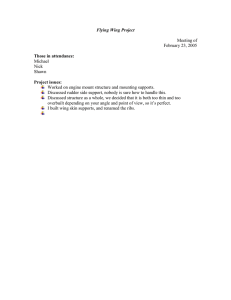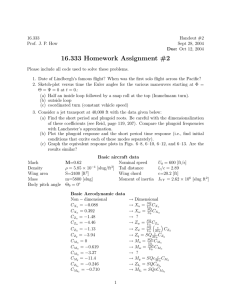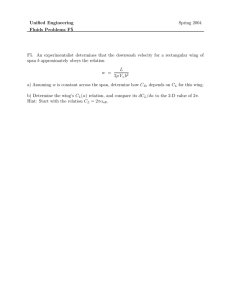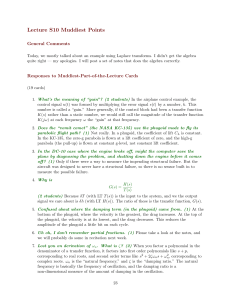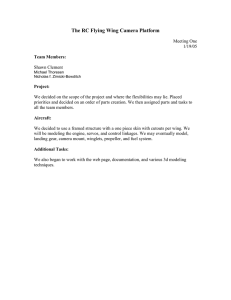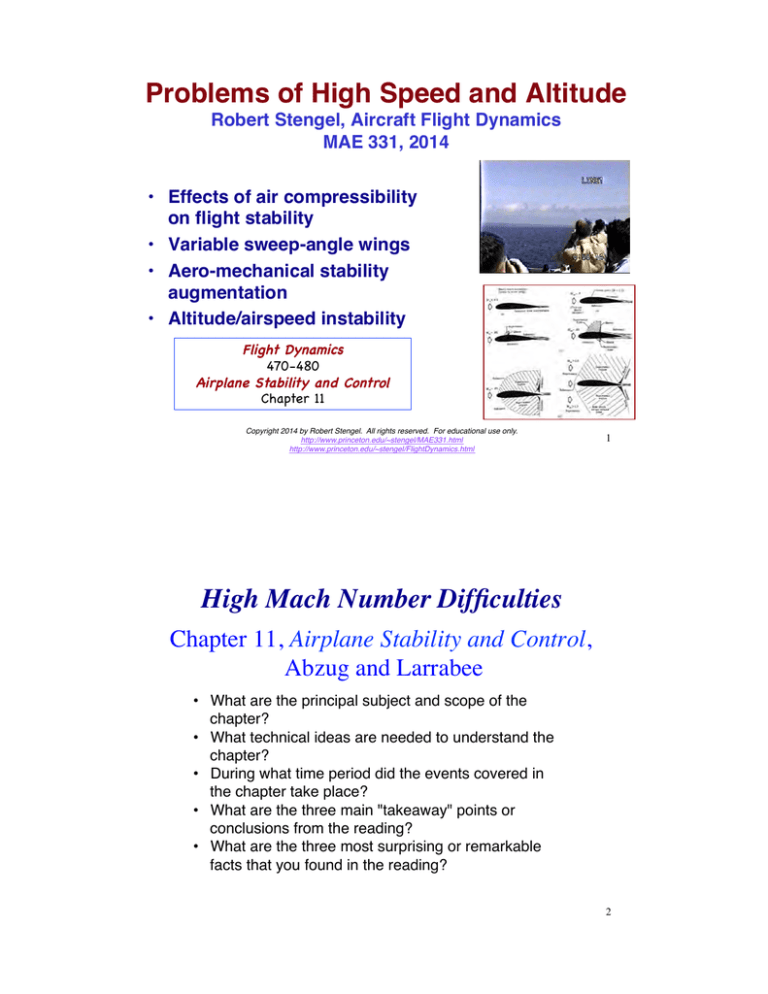
Problems of High Speed and Altitude!
Robert Stengel, Aircraft Flight Dynamics!
MAE 331, 2014"
•! Effects of air compressibility
on flight stability"
•! Variable sweep-angle wings"
•! Aero-mechanical stability
augmentation"
•! Altitude/airspeed instability"
Flight Dynamics!
470-480!
Airplane Stability and Control!
Chapter 11!
Copyright 2014 by Robert Stengel. All rights reserved. For educational use only.!
http://www.princeton.edu/~stengel/MAE331.html!
http://www.princeton.edu/~stengel/FlightDynamics.html!
1!
High Mach Number Difficulties!
Chapter 11, Airplane Stability and Control,
Abzug and Larrabee!
•! What are the principal subject and scope of the
chapter?"
•! What technical ideas are needed to understand the
chapter?"
•! During what time period did the events covered in
the chapter take place?"
•! What are the three main "takeaway" points or
conclusions from the reading?"
•! What are the three most surprising or remarkable
facts that you found in the reading?"
2!
Outrunning Your Own Bullets"
•!
•!
•!
•!
On Sep 21, 1956, Grumman test pilot Tom Attridge shot
himself down, moments after this picture was taken"
Test firing 20mm cannons of F11F Tiger at M = 1"
The combination of events
–! Decay in projectile velocity and trajectory drop"
–! 0.5-G descent of the F11F, due in part to its nose pitching down
from firing low-mounted guns"
–! Flight paths of aircraft and bullets in the same vertical plane"
–! 11 sec after firing, Attridge flew through the bullet cluster, with 3
hits, 1 in engine"
Aircraft crashed 1 mile short of runway; Attridge
survived!
3!
Effects of Air
Compressibility on
Flight Stability!
4!
Implications of Air Compressibility
for Stability and Control"
•!
Early difficulties with compressibility "
•!
Thick wing center section"
•!
Reduced downwash "
•!
Solution "
–! Encountered in high-speed dives from
high altitude, e.g., Lockheed P-38
Lightning"
–! Developed compressibility burble,
reducing lift-curve slope and
downwash"
–! Increased horizontal stabilizer
effectiveness "
–! Increased static stability"
–! Introduced a nose-down pitching
moment"
–! Auxiliary wing flaps that increased
both lift and drag"
NACA WR-A-66, 1943!
5!
P-38 Compressibility Limit
on Allowable Airspeed"
from P-38 Pilots Manual!
NACA TR-767, 1943!
•!
Static margin increase with
Mach number"
–!
–!
increases control stick
force required to maintain
pitch trim"
produces pitch down"
•! Pilots warned to stay well below speed of sound in steep dive"6!
Mach Tuck"
•!
Low-angle-of-attack phenomenon"
•!
F4D speed record flights (M = 0.98)"
–! Shock-induced change in wing
downwash effect on horizontal tail"
–! Pitch-down trim change, C mo , due to aft
aerodynamic center shift with increasing
Mach number"
–! Low altitude, high temperature to
increase the speed of sound"
–! High dynamic pressure "
–! 1.5 g per degree of angle of attack, M # 1,
dramatic trim changes with Mach number"
–! Pilot used nose-up trim control"
•! Pull to push for pitch control in turn at end
of each run"
•! Uncontrollable pitch-up to 9.1 g during
deceleration at end of one run, due to
s not compensating fast enough"
pilot
Abzug & Larrabee!
7!
MV Effect on 4th-Order Roots!
(
! Lon (s) = s 4 + DV +
L"
)
3
VN # M q s
(
)
L
L
L
$
'
+ &( g # D" ) V V + DV " V # M q # M q " V # M " ) s 2
N
N
N
%
(
L" '
LV
$
+ M q ( D" # g ) V # DV V + D" M V # DV M " s
&%
N
N)
(
L"
LV
gM " V + M V D" s + g V = 0
N
N
{
(
)
•! Coupling derivative: Large
positive value produces
oscillatory phugoid instability"
•! Large negative value produces
real phugoid divergence"
Short
Period!
}
Phugoid!
D" = 0
8!
•!
•!
•!
Pitch-Up
Instability"
High angle of attack
phenomenon"
Center of pressure moves
forward due to tip stall!
F-86 trim change (right)"
–! At t = 5 s, CN and Az are
increasing (pitch-up),
although elevator
deflection and control
force are decreasing"
NACA TR-1237!
9!
Transonic Solutions"
•!
Application of outboard vortex generators to delay tip separation
(Gloster Javelin example)"
•!
Mach number feedback to elevator on F-100 to counteract transonic
trim change"
10!
Supersonic Directional Instability"
•!
•!
•!
•!
•!
Reduced vertical stabilizer
effectiveness with increasing Mach
number"
Loss of X-2 on speed run"
F-100 solution: increased fin size "
X-15 solution: wedge-shaped tail"
XB-70: fold-down wing tips"
–! Improved supersonic lift "
–! Reduced excess longitudinal static
stability"
11!
High-Altitude StallMach Buffet"
•!
•!
•!
•!
•!
•!
Increased angle of attack and lift coefficient
"
leads to Stall buffet
Intermittent flow separation at transonic
"
speed and Mach buffet
The place where they meet = Coffin Corner
"
Can induce an upset (loss of control)"
U-2 operates in Coffin Corner"
Citation X (M = 0.92) has wide buffet margin"
U-2!
Citation X!
12!
•!
•!
•!
•!
•!
•!
Hypersonic Stability and Control"
Turbojet/rocket for launch/takeoff"
Ramjet/scramjet powerplant for cruise"
High degree of coupling, not only of phugoid and
short period but of structural and propulsive modes"
Poor lateral-directional characteristics"
Extreme sensitivity to angular perturbations"
Low-speed problems for high-speed configurations,
e.g., takeoff/landing"
DARPA HTV-2 Concept!
NASA X-43!
Boeing X-51A!
REL Skylon Concept!
B-3 Concept!
NASP (X-30) Concept!
http://www.youtube.com/watch?v=IiBsD-cafH8!
http://www.youtube.com/watch?v=VZUwKX3_uE4!
13!
Altitude/Airspeed
Instability!
14!
Supersonic Altitude/Airspeed Instability"
•!
Inability of XB-70, Concorde, and YF-12A/SR-71 to hold both altitude and airspeed
at high speed cruise"
–! Phugoid mode is lightly damped "
–! Height mode brought about by altitude-gradient effects"
–! Exacerbated by temperature/density gradients of the atmosphere"
•!
Engine unstart"
•!
Need for closed-loop, integrated control of altitude and airspeed"
–! Oblique engine-inlet shock is "spit out," decreasing thrust and increasing drag"
–! Can trigger large longitudinal or lateral-directional oscillations"
15!
Effect of Supersonic Mach Number
on Phugoid Mode Stability"
•! Characteristic polynomial for 2nd-order approximation"
!(s) = s 2 + DV s + gLV / VN = s 2 + 2"# n s + # n2
(
)
Ph
•! In supersonic flight (M > 1)"
DV = 2!" nPh
% M2 (
#' 2
& M $ 1 *)
•! DV decreases as M increases"
•! Phugoid stability is reduced in supersonic flight"
16!
Effect of Atmosphere
Variation on Aerodynamics "
•! Air density and sound speed vary with altitude, –z!
! ( z ) = !SL e" z
( )
a ( z ) = a zref +
#! ( z )
= "!SL e" z
#z
!a ( z ) !a
=
!z
!z
!a
z " zref
!z
(
)
•! These introduce altitude effects on lift, drag, and pitching moment!
.
( 1
+1
'V 2 S - 2
! / #$CT ( M ) " C D ( M ) %& *
)
,3
2m
Dz ! 0
; Lz =
!z
#
( 1
+%
! 4Cm ( M ) *
'V 2 Sc - 5
) 2I yy
, 5&
4
Mz = $
!z
#
( 1
+%
'V 2 S - 5
! 4CL ( M ) *
)
,&
2m
$
;
!z
M=
V
a
17!
Third-Order Model for PhugoidHeight Model Dynamics"
!!x height (t) = Fheight !x height (t) + G height !" T (t)
•! Neglecting Mz and short-period dynamics !
#
# !V! & % )DV
( % L
%
% !"! ( = % V V
N
% !!z ( %
'
$
%$ 0
)g
0
)VN
)Dz &#
( !V & # T*T &
(
(% !" ( + %
Lz
0
(
%
( !*T
%
(
VN
(
%
%
( !z ' $ 0 ('
0 ('$
•! 3rd-degree characteristic polynomial!
sI ! Fheight = " ( s ) = s 3 + DV s 2 + g LV
(
= ( s ! )h ) ( s 2 + 2* P+ nP s + + n2P ) = 0
VN
# L
&
+ Lz s +VN % DV z ! Dz LV ( = 0
VN
VN '
$
)
•! Oscillatory phugoid mode"
•! Real height mode!
(!
P
, " nP
#h
)
18!
Approximate Roots of the 3rdOrder Equation"
•! Assume phugoid response is fast compared to height mode response!
Phugoid Mode"
(
sI ! Fheight = " ( s ) = s 3 + DV s 2 + g
LV
Height Mode"
Lz
LV %
#
VN + Lz s + VN $ DV VN ! Dz VN & = 0
)
"
%
s $!s 2 + DV s + g LV + Lz '
V
#
&
N
(
Phugoid Mode"
! nP " g
Height Mode"
)
LV
!h " #
(
*
(g L V + L )**s +
V
N
)
VN + Lz ; # P "
VN $ DV
%
(
Lz
g
z
(
)
DV
2 g
VN # Dz
LV
" L
%+
VN $ DV z ! Dz LV ' VN
VN &
#
g LV + Lz
VN
,
VN + Lz
LV
)
LV
VN + Lz
&
VN '
19!
Equilibrium Response of Airspeed,
Flight Path Angle, and Height"
"1
!x SS = "Fheight
G height !#TSS
% !V
SS
'
' !$ SS
'
& !zSS
%
( ' "DV
* ' L
* = "' V V
N
* '
) ' 0
&
"g
0
"VN
"1
"Dz ( %
*
T#T
* '
Lz
0
'
VN *
* '& 0
0 *)
(
*
* !#TSS
*)
•! From Flight Dynamics, pp. 476-480, with negligible Dz!
# !V
SS
%
% !" SS
%
$ !zSS
#
T)T
%
DV
%
&
( %
0
(=%
L
( % +T . V V
N
' % * - )T 0
% , DV / Lz
%$
VN
&
(
(
(
( !)TSS
(
(
(
('
2 nd - order Approximation
!VSS = 0
!" SS =
T# T
!# TSS
g
•! Steady-state response to constant thrust increase "
–! Bounded airspeed increase"
–! Horizontal flight path"
–! Bounded altitude increase !
20!
Variable-Sweep/
Incidence Wings!
(“Morphing”)!
21!
Searching for the Right Design:
The Many Shapes of the XF-91
Thunderceptor"
•!
•!
Variable-incidence wing"
Tip chord > Root chord"
•!
Full nose inlet"
•!
Radome above inlet"
•!
•!
Vee tail, large tip chord"
Modified nose and tail"
22!
Early Swing-Wing Designs"
•!
•!
•!
Translation as well as rotation of the wing
(Messerschmitt P.1101, Bell X-5, and
Grumman XF10F, below)"
Complicated, only partially successful"
Barnes Walliss Swallow (right) concept
included “wing glove”, solution adopted by
Polhamus and Toll at NACA Langley!
P.1101"
X-5"
23!
Variable Sweep and Incidence"
General Dynamics F-111!
•! Variable sweep"
–! High aspect ratio for lowspeed flight"
•! Landing and takeoff"
•! Loiter"
–! Low aspect ratio for highspeed flight"
•! Reduction of transonic
and supersonic drag"
•! Variable incidence"
–! Improve pilots line of
sight for carrier landing"
24
! F-8!
LTV
•!
•!
•!
Boeing 2707-300
Supersonic Transport"
Variable-sweep wing dropped in favor of more
conventional design"
Final configuration had weight and aeroelastic
problems"
Project cancelled in 1971 due to sonic boom,
takeoff sideline noise and cost problems!
25!
Future of High-Speed Flight!
•! Commercial transport is likely to be subsonic
for the foreseeable future!
–! Luxury, comfort, and cost trump speed!
History!
Future!
•! Military requirements for human supersonic
flight are limited!
–! Selected missions require supersonic flight!
–! Majority of operational flight time is subsonic!
–! No new variable-sweep designs in development!
History!
Future!
26!
Future of High-Speed Flight!
•! Military requirement for UAV/Missile highspeed flight is significant!
–!
–!
–!
–!
Many missions do not require human presence!
Major weight reduction!
Major increase in payload ratio!
Current generation of low-and-slow UAVs
inadequate for high-intensity conflict!
27!
Next Time:!
Atmospheric Hazards to
Flight!
!
Reading!
Blackboard, Lecture 23!
Virtual Textbook, Part 23!
28!
!"##$%&%'()$*
+)(%,-)$*
29!
Compressibility Problems"
•!
Similar problems with P-39
Aircobra, P-47 Thunderbolt, and
P-51 Mustang "
–! Led to flight tests and greater
understanding of
compressibility effects"
Perkins, 1970!
30!
Transonic Pitchup Problem"
•!
•!
Sign reversal of Cm! with
increasing angle of attack "
–! Combined effect of Mach number
and changing downwash effects
on horizontal tail"
F-86 Sabre wind-up turn "
–! Turn at high bank angle, constant
load factor, decreasing velocity,
and increasing angle of attack"
NACA TR-1237!
31!
F-86 Flight Test: Attempt to Hold Load
Factor at 3 in Transonic Windup Turn"
Just below Pitch-up!
Just above Pitch-up!
Mach number!
Stick force, FE!
Elevator deflection, !E!
Normal force
coefficient, CN!
Normal load factor,
A z!
Pitch rate!
Pitch moment
coefficient, Cm!
Time, s!
NACA RM-A54C31, 1954!
Time, s!
32!
Effects of F-86 Blunt-TrailingEdge Aileron"
•!
•!
Mach Effect on Control of
Wings-Level Flight"
Effect of Aileron Modification on RollControl Effectiveness and Response"
Stick force!
Aileron!
Mach number!
Mach number!
NACA RM-A54C31, 1954!
33!
Phugoid and Height Modes of 5thOrder Longitudinal Model*"
Altitude = 70,000 ft!
M = 3!
Phugoid
Period, s"
Phugoid
Wavelength,
ft x 10-6"
Phugoid
Damping
Ratio"
Height
Mode Time
Constant, s"
* Short-period, phugoid, and
height modes"
!x T = [ !V !" !q !# !z ]
Stengel, 1970!
34!
Altitude Response of 5th-Order
Longitudinal Model"
Control Effects!
Disturbance Effects!
Vertical
Wind
Step"
Thrust
Control"
Lift
Control"
Horizontal
Wind Step"
Random
Vertical
Wind"
Moment
Control"
Stengel, 1970!
35!
•!
•!
Flying Tail of the
XF10F"
Variable-sweep successor to the F9F-6
Cougar and precursor to the F-14
Tomcat"
T-tail assembly with controllable canard
and no powered control"
–! Like a small airplane affixed to the fin"
–! Pitching moment was inadequate during
landing"
36!
•!
•!
Advanced Variable-Sweep Designs"
Fairing of wing trailing edge to
stabilizer leading edge at high
sweep"
–! reduces downwash at the tail and
corresponding pitch stability"
–! effectively forms a delta wing"
Wing glove/leading-edge
extension and outboard rotation
point "
–! provides greater percentage of lift
at high Mach number and angle of
attack"
Grumman F-14 Tomcat!
BAE Tornado!
37!
Swing-Wing Solutions"
•!
•!
•!
Fuel shift to move center of mass aft as wing sweeps aft"
Forward wing surface that extends as wing sweeps aft"
Advanced stability augmentation systems!
Rockwell B-1!
Grumman F-14 Tomcat!
Dassault Mirage G8"
38!
•!
•!
•!
Boeing 2707-200 !
Supersonic Transport Concept"
Length = 318 ft; 300 passengers; larger than the B-747"
M = 2.7 (faster than Concorde)"
Cancelled before construction!
Full-scale mockup!
http://www.youtube.com/watch?v=65gsjHhwV_8!
39!
Oblique Wing Concepts"
•!
•!
•!
High-speed benefits of wing sweep
without the heavy structure and
complex mechanism required for
symmetric sweep"
Blohm und Voss, R. T. Jones ,
Handley-Page concepts"
Improved supersonic L/D by
reduction of shock-wave
interference and elimination of the
fuselage in flying-wing version"
40!
NASA Oblique Wing Test Vehicles"
•!
•!
Stability and control issues
abound: The fact that birds and
insects are symmetric should give
us a clue (though they use huge
asymmetry for control)"
–! Strong aerodynamic and inertial
longitudinal-lateral-directional
coupling"
–! High side force at zero sideslip
angle"
–! Torsional divergence of the
leading wing"
Test vehicles: Various model
airplanes, NASA AD-1, and NASA
DFBW F-8 (below, not built)!
41!
Handley-Page Oblique Wing Concepts"
•!
Advantages"
•!
Issues"
–! 10-20% higher L/D @ supersonic
speed (compared to delta planform)"
–! Flying wing: no fuselage"
–! Which way do the passengers
face?"
–! Where is the cockpit?"
–! How are the engines and vertical
surfaces swiveled?"
–! What does asymmetry do to
stability and control?"
42!

